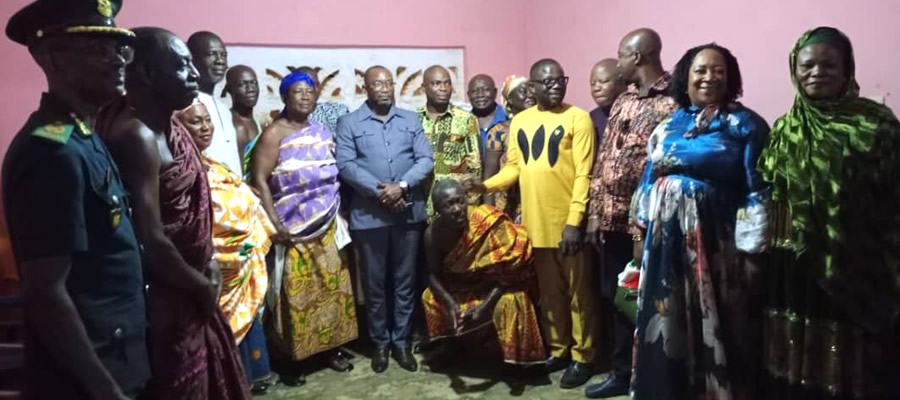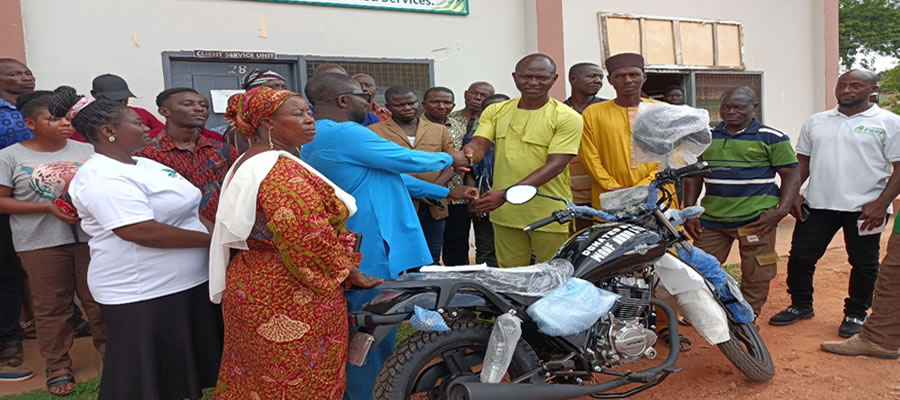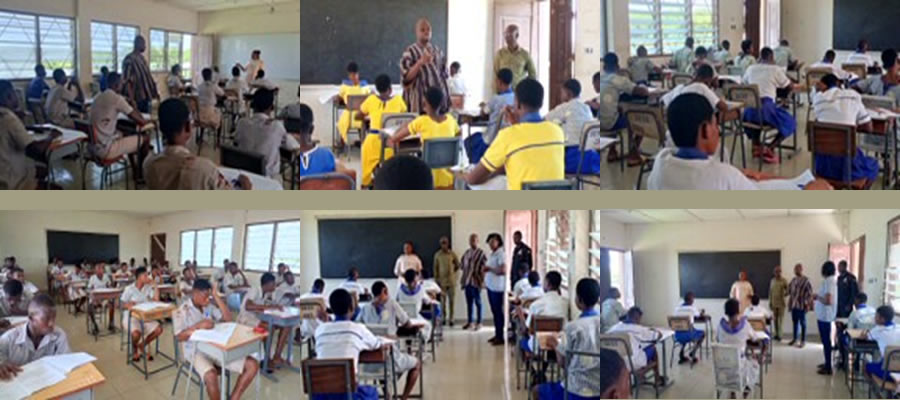

Literacy level is one of the key indicators in measuring human development. Over the years, the District Assembly, in conjunction with the District Education Directorate, has allocated huge resources to develop the sector. This notwithstanding the sector needs a very big push. Analysis on the educational sector in the District focuses on three main levels; Pre-school, Basic School (Primary and Junior Secondary School, JSS) and Second Cycle- Secondary
Pre-School Education
The official age range for pre-school education in Ghana is between 4 and 5 years. Data on pre-school education in the Kintampo South District is shown in the table below.
Pre-school Enrolment Rate
5,428 children are currently in pre-school in the District. Available data also indicate that, the population of age 4-5 years old in the District is 5,624. This gives a pre-school enrolment rate of 96.5% in the District. The table also shows that, enrolment in the public schools far exceeds that of the private schools. Enrolment in private schools accounts for only 7.4% of total pre-school enrolment.
The limited number of private pre-schools in the District could explain this. Again, the Government’s policy of free basic education through the capitation grant in public school is a factor for such a high disparity in enrolment for the private and public schools. The fee-free basic education has also accounted for the high enrolment rate of 96.5% at this level.
Classrooms and Teacher Requirements at pre-school under the Education Strategic Plan (ESP) which gives educational development, a target of 40 pupils per classroom at this level is expected to be achieved by the year 2010 considering the fact that, available classrooms for 5,428 pre-school pupils are 39, it means that, 136 classrooms are actually required for pre-schools in the District. This gives a shortfall of 97 classrooms. In this situation, there is bound to be overcrowding in existing facilities.
The pre-school teacher population of 139 as against the enrolment of 5,428 gives a Pupil Teacher Ratio (PTR) of 39:1. There is however the need for extra afforts to fully achieve the target by the planned period. The deplorable situation is that, only 2.2% of the 139 teachers at this level are trained.
Basic School Education
The basic school consists of the primary and the Junior Secondary School (J.S.S.) levels and involves children whose ages range between 6 and 14 years. That is 6-11 for primary and 12-14 for J.S.S. The number of basic schools, enrolment and teacher population are shown in the table below.
Enrolment/Participation Rate in Basic Education
Statistics based on the 2000 population census show that 15,284 made up of 7,994 boys and 7,290 girls fall within the primary school going age of 6-11 years. For the J.S.S age of 12-14 years, 2,808 boys and 2,605 girls giving a total of 5,413 children are within the group in the District.
Given the Primary School enrolment of 10,461 it indicates that the school participation rate at this level is 68.4%. That of the J.S.S is 38.1%. Both the Primary and J.S.S. participation or enrolment rates are very low comparatively. There is therefore the need for more pragmatic measures so as to meet the National target of 100% enrolment/participation rate.
Provision of Basic School Infrastructure
At the Primary School, a total of 220 classrooms currently exist. Given that one classroom accommodates 40 pupils, the available classrooms can accommodate 8,800 pupils. This represents 84.1% of total Primary enrolment. It is therefore obvious that, there is overcrowding in classrooms. The situation is however different at the J.S.S. level. With an enrolment of 2,063 there are 67 classrooms at this level with the capacity to accommodate 2,680 pupils. And average of 31 pupils per classroom is thus possible at the J.S.S. level.
Teacher Demand at the Basic School Level
The teacher demand was determined through the use of the Pupil-Teacher Ratio. The PRT in the District currently stands at 35:1 for the Primary and 18:1 for the J.S.S. The PTRs for both levels are just within the National Standard of 35:1 for Primary and 18:6:1 for the J.S.S.
The disturbing issue is the high proportion of untrained teachers in the Primary Schools. Untrained teachers accounts for 56% of teachers at the Primary School level. The J.S.S. however had a lower number of untrained Teachers, which account for 31.3% of teachers at that level. It is imperative therefore to increase the number of trained teachers in the District as a measure to improve quality in education, which has been identified as one priority area for attaining a middle-income status.
Second Cycle Education
The categories of institutions that fall within the Second Cycle Education include Senior Secondary School (S.S.S.), Technical/Vocational Schools and Commercial Schools. The Kintampo South District however has only one Senior Secondary School located in Jema, the District Capital. The school has a population of 546 of which 343 or 62.8% are males and 203 or 37% are female.
The teacher population at the Secondary level is currently 26, that is 22 males and 4 females. The student Teacher Ratio of 15.2:1 is almost equivalent to the National Standard of 15:1 The analysis also adopted the threshold population for the Second Cycle education based on a threshold population of 20,000 required for a Second Cycle institution, it means that the current population of 93,000 of the Kintampo South District, four (4) second cycle institutions are required by the District. There is therefore a shortfall of three (3) schools at this level.
Girl-Child Education
Education of the girl-child has become one of the major concerns of the nation in view of the low participation of girls in education. Table 2.12 shows the gender parity index GPI, for the various levels of Education in the District.
The Gender Parity Index measures the proportion of school going age for girls who are actually in school against that of the boys. The table above indicates that for the Primary School level, the population of 6-11 year olds who are in school is 82.7% of that of their male counterparts. At the J.S.S level, this is 82.5%. The GPI for the various levels are still very low even though the targeted attainment date is 2005 under the GPRS I
Key Development Problems, Opportunities/Potentials
The problems and opportunities are identified under the various levels namely; Pre-school, Basic, Second cycle and educational management.
Pre-School Level
- High proportion of untrained teachers
- Inadequate facilities
- Poor quality classrooms creating a situation of insecurity to the children
- Low proportion of trained teachers (2.2%)
- Low private sector participation in education delivery
Existing Potentials at Pre-school level. Among the opportunities/potentials of pre-school level in the Kintampo South District are:
High enrolment rate
Key development problems facing the basic school in the District are:
- Inadequate classrooms
- Uneven distribution of schools
- Low school participation rate (68.4) for Primary and 38.1 for J.S.S
- High proportion of untrained teachers at the Primary School level (56%)
- Inadequate furniture
Key problems associated with Second cycle education in the Kintampo South District include the following:
- Inadequate infrastructure
- Low gender parity index
- Inadequate schools for Second cycle education
- Lack of accommodation for staff
Potentials
Adequate teachers at the Second Cycle institution
Enabling environment for private sector participation in second cycle education
Date Created : 11/17/2017 1:43:43 AM











 facebook
facebook
 twitter
twitter
 Youtube
Youtube
 +233 593 831 280
+233 593 831 280 0800 430 430
0800 430 430 GPS: GE-231-4383
GPS: GE-231-4383 info@ghanadistricts.com
info@ghanadistricts.com Box GP1044, Accra, Ghana
Box GP1044, Accra, Ghana